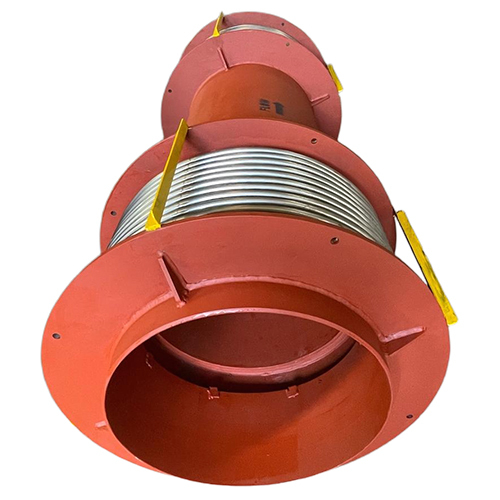Universal Expansion bellows
Product Details:
Universal Expansion bellows Price And Quantity
- 30000.00 - 1000000.00 INR/Unit
- 1 Unit
Universal Expansion bellows Trade Information
- Vadodara, Gujarat
- 10 Unit Per Week
- 7 Days
- Truck Load
- All India
- ISO 9001 : 2015
Product Description
A Universal Tied Expansion Joint (also called Universal Tied Bellows) is designed to absorb large amounts of lateral (transverse) movement and some axial movement. It consists of two bellows elements connected by a center spool, with tie rods to restrain internal pressure thrust.
What a Universal Tied Expansion Joint Contains
| Component | Description |
|---|---|
| Two Bellows Elements | Corrugated metal (e.g., stainless steel), one on each side of the joint to allow flexibility in multiple directions. |
| Center Spool (Pipe/Spacer) | A straight pipe connecting the two bellows, often customized in length based on lateral movement requirements. |
| Tie Rods (Tie Bars) | Usually 4 rods running parallel to the pipe axis, fixed between the ends to restrain pressure thrust while allowing lateral deflection. |
| End Connections | Weld ends or flanges for installation into the piping system. |
| Gusset Plates / Lugs | Welded plates on ends to mount the tie rods. |
| (Optional) Internal Sleeves | Protect bellows from media flow and reduce turbulence. |
| (Optional) Flow Liners | Improve flow characteristics and reduce erosion/corrosion inside the joint. |
Key Functional Characteristics
| Feature | Description |
|---|---|
| Movement Types | Primarily lateral, limited axial (depending on tie rod design and flexibility). No angular unless specially designed. |
| Pressure Thrust Restraint | Fully restrained by tie rods, minimizing the need for strong anchors. |
| Flexibility Range | Greater lateral movement capability compared to single-bellows designs. |
| Durability | Ideal for long pipe runs and thermal expansion in multiple directions. |
Applications
-
Long pipe runs (e.g., pipelines, utility tunnels)
-
Steam, gas, or chemical lines with significant lateral deflection
-
Systems with thermal expansion across offsets or loops
-
Piping where space constraints make axial expansion joints impractical
Design Notes
-
Tie Rod Orientation: Parallel to axis ï restrains pressure thrust but allows lateral movement.
-
Anchor Requirements: Less demanding than untied joints, but guides and intermediate anchors are still needed.
-
Bellows Material: Often stainless steel 304/316, Inconel, or Hastelloy depending on temperature and media.

Price:
- 50
- 100
- 200
- 250
- 500
- 1000+





 Send Inquiry
Send Inquiry Send SMS
Send SMS English
English Spanish
Spanish French
French German
German Italian
Italian Chinese (Simplified)
Chinese (Simplified) Japanese
Japanese Korean
Korean Arabic
Arabic Portuguese
Portuguese